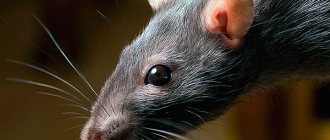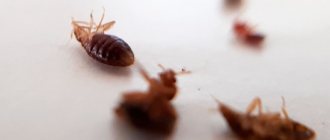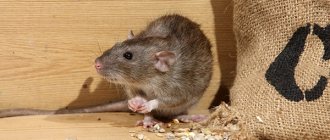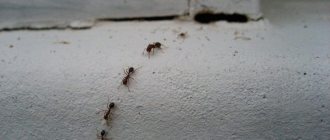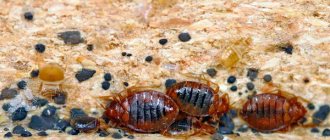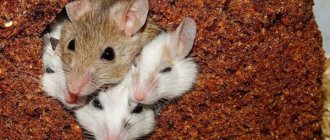Rats often choose country houses, food warehouses and other premises with food sources and unfavorable sanitary conditions as their habitat. The appearance of rodents near a person threatens not only spoiled things and food. If at least one individual is found in the house, the control process should immediately begin. Animals are distinguished by good survival and adaptability, high productivity, which allows them to quickly increase their population size.
Rats are carriers of pathogens of many dangerous diseases and infections. The fight against rodents begins with studying information about the characteristics of their life, reproduction, and physiology. The result of extermination measures will largely depend on knowledge of what rats are afraid of. In the fight against rodents, it is important to deprive animals of comfortable living conditions, cut off the path to a food source, and use preventive measures to prevent the reappearance of unwanted individuals. To do this, you should keep the room clean, avoid the accumulation of garbage and unwashed dishes, and do not leave food in the public domain.
The arsenal of modern means aimed at getting rid of rats is presented in a wide variety - these are folk remedies, repellent smells and sounds, various traps with glue and poisonous baits, chemicals, ultrasonic equipment. They differ in their effectiveness. The choice of a specific method should include an analysis of the situation and a preliminary assessment of the population size. The process of fighting rats is complicated by the rapid adaptation of rodents to new conditions and unfavorable factors.
What rats are really afraid of and don't like
Perhaps the main problem of repelling rats is that, with rare exceptions, these animals are afraid of the same smells and sounds that are unpleasant to humans.
To get rid of rodents without disturbing your comfortable living indoors, you should use means that are familiar to humans or completely invisible, but which rats cannot tolerate. Among them:
- Ultrasonic rodent repellers (high-quality, not Chinese tweeters) - people do not hear ultrasound, but rats perceive it and at a certain frequency and intensity - they are afraid (more precisely, they experience discomfort);
- Cats (and to a lesser extent, their smell);
- Bright light (provided that the animals are not used to it);
- Loud sounds;
- Sounds with which rats themselves transmit danger signals to each other.
A common disadvantage of such influences is that rats can get used to them, and the longer a particular sound or smell affects rats, the less they can be afraid of it. This means that when using one or another option, you should always take into account the likelihood of rodents developing individual immunity to deterrents.
Fortunately, addiction in animals does not develop very quickly, and it is often possible to drive them away long before they become immune to one or another influence.
On a note
To effectively fight rodents in a private home, it is also useful to know which insulation is not chewed by rats and mice, since the wrong choice of insulation can create ideal conditions for rodents to live in the walls of the house and in the attic. We’ll talk about this in more detail below, but for now we’ll just note that, contrary to popular belief, glass wool in most cases is not able to scare away rats - rodents can easily make their moves in it.
Folk remedies whose repellent abilities are questionable
Folk art is replete with ideas and recipes for remedies that rats should supposedly avoid, but in practice this often does not happen.
Here are just the most famous of them:
- Vinegar - It is believed that rats are afraid of it due to its strong, unpleasant odor. Some even try to use vinegar essence, which is unsafe to use, for this purpose. At the same time, however, it is silent that not only rodents, but also the residents of the premises will have to inhale the aroma of vinegar;
- Essential oils and perfumes. It is highly doubtful that the animals that have conquered the whole world from India to the USA would shy away from the exquisite aromas of world-famous perfume houses or the smells of essential oils. Such means can alert them, but are not able to drive them out of the house;
- Bleach - Rats actually avoid places that smell too strongly of bleach (bleach releases small amounts of chlorine gas into the air, a very caustic, poisonous gas). However, the active use of bleach in an apartment or house is a dubious idea, since the residents themselves will have to inhale such an aroma. In addition, the duration of action of the product is short, since bleach quickly loses its activity in the air;
- Naphthalene - rats are not always afraid of it, and, moreover, this same product is recognized as a carcinogen and is prohibited for use in residential premises;
- Ash. The use of ash to repel rats is a typical folk myth, since it does not cause any fear or particular discomfort in rodents;
- Broken glass falling asleep in rodent passages is also a kind of unfounded legend;
- The smell of burnt rubber and burnt fur - such folk remedies may indeed frighten rats once, but they are not capable of becoming a reliable permanent means of fighting them;
- Turpentine, kerosene and gasoline - the same applies to them as to vinegar. And in addition, they are also fire hazardous;
- Burdock thorns, which supposedly frighten animals by clinging to their fur. Actually ineffective;
- Tobacco or cigarettes - despite their strong smell, they practically do not repel rodents.
In general, rats are not afraid of water (moisture) and cold. They feel great in damp basements, can swim for a long time (in nature they are known to catch ducklings and frogs in the water), and can easily tolerate the cold if they have access to food sources. Situations have been described in which rats lived for several generations in freezers at an air temperature of -18°C, breeding inside frozen pork carcasses. Therefore, airing a house or apartment in winter will not help get rid of rats.
Source
How to drive rats out of non-residential premises
If it is necessary to expel rats from a non-residential premises, for example, a bathhouse or a barn, then you can use products that emit a strong odor. And here we are not talking about special chemicals. But what smell are rats afraid of? Let's look at this issue in detail.
Vishnevsky ointment
It must be diluted with water to obtain a thick consistency. The resulting mixture should be spread on the floor in a non-residential area and closed for several days. It is important to note that Vishnevsky’s ointment is not suitable for external treatment.
Singed wool
It is necessary to burn natural fur over a fire and bring it indoors. Also suitable for this method are fluff or burnt rubber. It is installed next to the minks.
Various substances
These include:
- kerosene;
- tobacco;
- vinegar;
- bleach;
- hot peppers.
Do not forget that during the treatment all animals and birds should not be allowed into the room, and after the treatment the building must be ventilated.
Herbal essential oils
In pharmacies you can buy essential oils that are prepared from herbs. The aroma from the essential oil will be stronger and richer than from fresh or dried herbs. It will be felt longer.
It is known that rats are afraid of the smell of peppermint essential oil. The same goes for mice. The oil is dripped onto cotton pads or napkins and placed in the corners of the rooms.
You can drop a few drops into the water before washing the floors. The smell will be felt throughout the house, so you shouldn’t overdo it. The pungent aroma causes headaches and dizziness.
In addition to mopping the floors, you can diffuse essential oil from a spray bottle. To do this, drop from 1 to 15 drops of oil into 300 ml of water and add 10 ml of alcohol. The mixture is applied wherever animals may be.
Special aroma lamps are sold in stores. The essential oil evaporates along with the smoke, and the smell penetrates into all the cracks.
Direct contact of the animal with the oil must be avoided. If it gets on the fur of a rodent, it will lead to death. For lovers of humane methods of elimination, murder is definitely not suitable.
Plant control
Representatives of previous generations knew what grass mice and rats are afraid of. The repellent smell forces them to leave human possessions. The presence of the potion protects against re-infection
Expulsion from non-residential premises
Several plants have been used since ancient times, which have repeatedly proven their effectiveness. Application does not require special skills, but caution is required:
- Elder. They lay them out along the walls, in the corners, and stuff them into holes. Protection is updated after a week. At the dacha, in the garden, an elderberry bush is planted. You don't have to invent anything with smells. In an apartment or residential building, elderberry is used with caution, since the plant contains toxic hydrocyanic substances. It is forbidden to use this herb against mice if there are animals or small children in the house.
- Ledum. The poisonous properties of wild rosemary have been known for a long time. The plant not only repels mice and rats with its smell, but can also kill. Ledum essential oils are hazardous to human health and are recommended for use in non-residential premises, warehouses, barns, and garages. The repellent smell lasts about 10 days.
- Blackroot officinalis. No plant can compare with this potion in terms of effectiveness. The potion is popularly called a rat killer. The plant has a sharp, repellent odor, as well as many spines that contain poison. Upon contact with blackroot, the spines cling to the fur of rodents, dig into the skin, and release toxic substances. Rodents are most afraid of contact with this plant. To poison pests, the seed is mixed with flour and sugar.
Plants against rodents
Important!
When working with a dangerous potion, you must protect your hands with rubber gloves and wear a gauze bandage. The black root is dipped in boiling water for a few minutes and placed in the right places.
The repellent effect of the plants lasts as long as the aroma lasts. With its disappearance, performance decreases. Bundles of potion should be renewed periodically to maintain the smell. It is also necessary to alternate scents, since with prolonged use, pests become addicted.
Expulsion of rodents from residential premises
Plants against rats and mice are used in apartments and houses. But they use a potion that is safe for human life and health:
- sagebrush;
- pharmaceutical camomile;
- tansy;
- peppermint;
- pyrethrum.
The smell of chamomile, mint, and pyrethrum has a beneficial effect on a person’s well-being - it calms the nervous system, normalizes sleep, and improves breathing. For rats and mice, the smell is one of the most annoying and unpleasant.
Anti-rat grass in the house The plant is placed around the perimeter of the rooms, in the corners. You can use dry potion, fresh. But it should be updated as the smell disappears. For greater efficiency, create a bouquet of several components.
You need to be careful with tansy and wormwood. The rich smell of these plants drives rats and mice out of the room in a matter of days, but can harm humans. Headache, nausea, weakness, and sleep disturbance appear. To avoid this, you need to distribute the potion in small quantities. Rodents' sense of smell is much sharper than that of humans; they detect even the faintest odors.
On a note!
Instead of plants, you can use essential oils to repel rats and mice. Drop onto a napkin, add to water for washing floors, apply to a light bulb, saturate a candle or wood. Carrying out the daily procedure in the evening makes life unbearable for pests, but for humans it will smell pleasant. After a few days the animals will leave the premises.
You can create living protection around the house - plant mint bushes around the perimeter, spread chamomile, tansy, or other fragrant herbs. Plants prevent rats and mice from leading a full life; you can get rid of them without using dangerous poison.
Additional methods
You can scare away rats with harsher substances. Among the folk remedies you can find turpentine, kerosene, cologne, ashes from the skins of killed rats, etc. All substances are toxic and have a pungent odor. Therefore, the use of most products in an apartment or residential building is impossible.
Kerosene
It is recommended to spray the habitats of parasites with kerosene. In basements and attics it makes sense to install a container with liquid. The smell of fuel will emanate constantly. Therefore, rodents will try not to return to their habitual place. If the animal gets into the liquid, it will die.
Naphthalene
Naphthalene has a sharp, specific odor. The solid substance not only repels rodents, but is also toxic to them. It is recommended to mix naphthalene with sawdust and scatter the mixture in mouse habitats. Such flooring will cause animals to panic and try to leave the room. It is recommended to use mothballs to remove rodents from non-residential premises.
Turpentine
Turpentine has a similar effect to kerosene. The liquid has a pungent odor that causes discomfort to living beings. It is recommended to coat the corners of the room with turpentine, or place a container with it next to mouse holes. The aroma of fuel persists for a long time and does not dissipate well, so rodents do not appear for a long time.
Burnt fluff
Burnt feathers are another effective method of repelling parasites. Pests cannot tolerate the smell of burnt fluff and avoid its locations. You can burn any feathers. Duck down has the most unpleasant aroma. Ashes must be mixed with starch and scattered in places where rodents have been seen.
Burnt rat fur
It is believed that rats are acutely aware of danger. Therefore, people have been using the method of repelling rodents for many years, which involves the use of the corpses of their relatives. Killed rodents must be skinned and burned. After this, the singed wool becomes the most terrible rat repeller.
Cologne
Cheap cologne, which you can buy at a department store, is an effective mouse repellent. The perfume has a sharp and persistent odor. Sensing the aroma, rodents try to retreat. It is recommended to use cologne not only in outbuildings, but also in apartments.
Chlorine solution
Bleach and chlorine-containing substances not only repel rats, but also kill them. Experienced housewives place jars of whiteness around the house. They prevent rats from leaving their holes. If the liquid enters the body, the animal dies.
Jars with chlorine solution must be covered with a plastic or metal lid, after making several holes in it.
Glass wool
Glass wool does not emit an odor, so it is used in residential areas. Insulation is added to food baits, which must be placed near mouse holes. Once in the body, glass wool injures the rodent's stomach. This causes instant death of the animal from internal bleeding.
Glass wool can be added to the soil mixture and sprinkled over the paths along which mice move.
The magical power of nature
There are a huge number of plants that effectively fight against mice. What aroma do they not tolerate?
- Blackroot is a poisonous perennial that not only repels mice, but also kills them. In its thickets, the pest quickly dies, for which it does not even need to taste the grass. Thanks to the large amount of poisonous alkaloids, the rodent simply goes crazy. It is not surprising that mice sense a threat and avoid the blackroot.
- Elderberry root, which produces poisonous hydrocyanic acid.
- Swamp wild rosemary, the smell of which rodents cannot stand.
Remember that these three plants are poisonous, so they are not recommended for use in a home where there are small children, cats and dogs. There is a chance that they will not resist the temptation to try interesting twigs for their teeth. Don’t forget about personal safety measures and use gloves.
In residential areas, it is better to use herbs that will definitely not cause problems. The aroma will help drive out pests:
- wormwood with a characteristic bitter scent;
- hazel grouse bulbs with a sharp garlic amber;
- peppermint, the smell of which is pleasant to humans, but “deadly” to rodents;
- tansy, feverfew and regular chamomile;
- aboveground parts of beans, tomatoes and potatoes.
Using the scents of natural enemies
It's no secret that rodents are afraid of cats, which are considered their main “thunderstorm.” However, this trend is more true for village cats than for pets living in comfortable apartments.
But should you be upset if your purr runs away in fear from one type of mouse, and you can’t rely on his hunting instincts? No, because you can drive out uninvited gray guests using the smell of a cat, or rather its urine. To do this, you can place used cat litter near the holes or soak rags with urine. Inhalation of ammonia vapor leads to a sharp decrease in the number of mouse offspring, causing the population to die out faster.
However, even more than cats, small rodents are afraid of snakes and rats. For the former, they act as natural food, while the latter fight with them for the same food sources and destroy their burrows. Therefore, mice can smell the excrement of their enemies a mile away and avoid them. You can easily become the owner of this “wealth” in any pet store.
Using these methods in an apartment is not very pleasant, but they are quite suitable for dachas, vegetable gardens and non-residential premises.
Special cases
Sometimes you can feed the animals with baby food in the form of puree from jars. Children's or diabetic cookies without sugar or sweeteners can act as a treat.
Dark chocolate will not harm you if you give it infrequently. Rats should not be given tea or coffee, and herbal infusions are safe only if prescribed by a doctor. Sweets, jam and chips are excluded.
The set of permitted products is shown in the table.
Table of permitted and prohibited products
Source
Using the contents of the kitchen cabinet
If you don’t have a cat and don’t want to spend money on purchasing plant extracts, ordinary spices available in the arsenal of any housewife will help. The smell will help save supplies from the invasion of gray guests:
- carnations;
- coriander or cilantro;
- red pepper;
- sage;
It is allowed to use powder or seeds of these seasonings. Dry sage leaves, which are best burned, are also suitable. The strong aroma of coffee will also help repel rodents; freshly roasted beans work best.
Also, pests do not like the scent of vinegar, which can be poured into small containers and placed around the room. Although this option is more suitable for protecting cottages from rodents in the winter, since constantly inhaling a pungent odor is not only unpleasant, but also unsafe. The aroma of bleach scattered in the corners is also suitable for the same purpose.
LiveInternetLiveInternet
—Tags
—Categories
- knitting (4229)
- sweet life (3586)
- to the delight of meat eaters (3127)
- sore point (2695)
- amazing baked goods (2440)
- I will be better. (2266)
- let's have a snack (2188)
- let's hit the vegetables (1619)
- cellar (1483)
- tips for life (1277)
- not a day without salad (1143)
- fish day (866)
- unusual dessert (841)
- outdoors, in the garden and vegetable garden. (806)
- poetry of colors (803)
- sewing and cutting (651)
- holiday (562)
- I will lose weight 100% (497)
- alluring world of flowers (487)
- handmade (427)
- what's first? (410)
- the pain of the soul flowed onto the paper (381)
- music inside us (319)
- interesting story (287)
- wine cellar (284)
- please speak (261)
- interior (183)
- we fast tasty, satisfyingly, with pleasure (183)
- books, films (182)
- PunchMorsCocktail (154)
- like an echo of days long gone (photo) (123)
- bread is the head of everything (114)
- pizzeria at home (112)
- tea break (81)
- coffee aromas (79)
- a thought appeared (77)
- cooking from. from appetizer to dessert (62)
- we study ourselves (35)
- in palms - crumbs (26)
- computer help (5)
—Search by diary
—Subscription by e-mail
-Statistics
Ultrasound and methods of its application
Rats and mice hear sound with a frequency of up to 80-100 kHz, while humans are no longer practically unable to perceive vibrations with a frequency above 20 kHz. Sound with a frequency above 20 kHz is called ultrasound, and it meets one of the requirements for rodent repellents - to affect rats and mice without affecting humans.
It has been verified that devices that emit sound waves with frequencies from 20 kHz to 70 kHz can indeed repel rats quite effectively. In this case, an effective repeller must not only generate ultrasound, but also have a number of other important characteristics.
Here are the most significant of them:
- High sound pressure (a parameter similar to volume, but in the ultrasonic range). The higher the sound pressure, the higher the likelihood that rats will not tolerate the sounds produced by the device and will leave the area;
- The wide directional pattern of emitted ultrasound determines in which direction and how widely the sound travels. Ideally, it should approach 360°, that is, in fact, ultrasound in this case will spread evenly around the entire repeller. Most devices claim this angle, but in fact their ultrasonic radiation pattern barely reaches 50°;
- Automatically changing ultrasonic frequency. It is important to understand that not all ultrasound scares rats. Just as not every sound causes discomfort in humans, not every ultrasound repels rodents. But if the device constantly changes the frequency of the emitted ultrasound, then periodic discomfort will not be avoided for rodents.
The most effective ultrasonic repellers against rats today include Biostrazh, Chiston 2, Chiston 2 PRO, Tornado 800, TM-315 and some others. They are also one of the most expensive. More affordable devices are not as powerful, and some of the cheapest ones are outright junk, useless and not at all capable of scaring rats.
In addition, rats can get used to ultrasound, just like any other sounds. This, although rare, does happen. In this situation, pests may leave the room at first when the device is turned on, but then they will return again.
Ultrasonic repellers, when used correctly, do not have a negative effect on people, but may cause headaches for some. It should also be taken into account that cats and dogs hear ultrasound well, especially domestic mice, rats and hamsters, and therefore if there are pets in the house, such a device may not be able to be used.
They'll still get you
Monsters from classic horror films are scary not only and not so much because of their bloodthirstiness. They are almost unstoppable - this is what makes us sit back in our chairs
You can lock yourself up as many times as you like and take any precautions you want, but if Jason from Friday the 13th, Freddy from A Nightmare on Elm Street or some "Woman in Black" is hunting you, you have a chance... yourself you understand
It's the same story with rats. Even though you might hurt yourself trying to figure out how to protect your home from them, if a rat decides to come visit you, he will do it, rest assured. It costs nothing for a rat to climb up any ventilation. Let's say you provided for this possibility and plugged all the holes. However, as it turned out in the course of one study (.pdf), it costs nothing for a small rat to lift an object weighing more than a pound (~0.5 kg; approx. mixstuff.ru), if it has suspicions that the parquet flooring is more appetizing on the other side .
They can squeeze into tiny holes - no more than a quarter of the rat's girth in diameter. This is an almost finished T-1000 from the second part about the Terminator: cover it with a steel net and it will leak between the bars before you can blink an eye.
They have another favorite way to penetrate our homes - through pipes. Moreover, four centimeters in diameter is quite enough for them. And yet, they are champion swimmers. Combine these two skills and you get an animal that might one day emerge from your toilet. And such cases are not uncommon.
Let's say you manage to block this opportunity for them - so what? If they have already taken on you, they will gnaw a separate entrance for themselves through the wall, and they will not lose anything. Nature (apparently to keep us on our toes) has endowed rats with incredibly strong, even for rodents, jaw muscles. And while some bunny is peacefully gnawing on the bark of a tree, give these small creatures brick, cement and even lead. Their incisors grow throughout their lives, and they have no choice but to constantly grind them down.
Loud sounds
This factor is very specific: rats are really afraid of loud sounds, but it is inconvenient to use them in a living room. As an exception - loud music, in which pests will not dare to get out of their hiding places, but it is impossible to listen to it around the clock, and at night, in silence, the animals will calmly rule in the kitchen or basement.
On the other hand, rats are afraid of noise only until it becomes familiar to them. And they get used to different sounds quite quickly, especially if you try to scare rats often and regularly. Therefore, to scare away rodents, it is irrational to use ordinary sounds audible to humans.
On a note
Like most wild animals, rats, even indoors, are also afraid of quiet sounds - various rustles and creaks. This is understandable: in the wild, a predator always creeps up on its prey quietly, trying to make a minimum of sounds, and therefore the quiet crack of a broken twig under its paw or the rustling of leaves foreshadows great dangers for the rat.
At the same time, at large industrial enterprises - grain warehouses, transshipment depots, ports - rats calmly collect grain under trucks with running engines, run under rumbling conveyors with vegetables and nuts, and do not pay attention to noisy presses at oil extraction plants. They know that these particular noises do not pose any danger to them.
Light
Rats are nocturnal animals, and other things being equal, they prefer to be in dark places and go out in search of food at dusk and in the dark. However, they easily and quickly adapt to light, and if they do not encounter any dangers in illuminated places and in bright rooms, they quickly cease to be afraid of light. Often, rats become diurnal and forage in daylight.
This means that although in general rats are afraid of light, it will not be possible to use this as a permanent repellent. If you leave the light on in the room, then after a few days the animals will stop paying attention to it.
On a note
Interestingly, due to the specific nature of their vision, rats do not perceive infrared light. In zoos, this is used to switch nocturnal rodents to daytime mode: during the day a red light is on in the enclosure, and the animals believe that they are in the dark, and at night a regular incandescent lamp is turned on, and the rodents go to sleep. As a result, visitors during the day can observe animals that lead a nocturnal lifestyle.
Rat "screams of terror"
Like some other animals, rats can be repelled by playing their own danger signals. This method is sometimes used to scare away birds and to control monkeys on tropical farms. Once a recorded cry of danger is enough to use it almost constantly and effectively.
It’s also useful to read: 8 effective DIY rat traps
However, some rules must be followed:
- The sound should not be played regularly so that the animals do not get used to it;
- The sound should be clearly audible throughout the room;
- The actual cries of danger must be recorded, and not just squeaks;
- Recording and reproducing equipment must capture the ultrasonic frequency range.
In domestic conditions, the implementation of this method will in most cases be ineffective. Firstly, using a smartphone or computer microphone to record rat squeals is not the best option, since the ultrasonic component will not be recorded at all (even vibrations above 15-17 kHz will be recorded with distortion). Secondly, reproduction will also require emitters (speakers) capable of reproducing ultrasonic vibrations without significant distortion. Well, and thirdly, few people would want to live in a house where a loud rat squeal is constantly suddenly heard.
The use of ultrasonic rat and mouse repellers in this regard would be more justified.
On a note
People know the harsh old-fashioned way of scaring away rats: they used to simply catch a live rat and nail it to the wall. While the animal was dying, its relatives heard the terrible screams of its agonizing fellow. However, for humane reasons, such a method should in no case be considered for practical implementation.
Pest prevention
Dealing with a rat infestation is a difficult task that requires an investment of money and nerves. Isn't it easier to prevent proximity to parasites? Remember that rats and clutter are two closely related things, so follow simple rules and pay due attention to cleanliness.
Adhering to useful recommendations and “getting acquainted” with rodents does not promise you:
- regularly clean the area near your house; the presence of freely accessible garbage is an invitation to rats;
- Monitor the condition of the garden and trees. The presence of garden waste attracts rodents, and later they will want to move into the house;
- carefully inspect the house for cracks, holes, and other openings that could become a way for a rodent to enter the room. Use a fine metal mesh and seal all existing ventilation ducts with it;
- Pay special attention to water sources in the house and near it. Rats need water daily; its absence will scare away uninvited guests. Fix leaking pipes in the house, close the toilet lid at night;
- Do not leave pet food bowls out overnight;
- Store all food supplies in tightly closed containers, do not leave crumbs on the table, and do a thorough cleaning of the house at least once a month.
Simple rules will help protect your home from rodents, even other parasites that can significantly ruin your life.
Rats are dangerous parasites that require constant control; if several individuals are not exterminated in time, you will have to deal with a huge infestation of pests in the house. If necessary, involve your neighbors in the fight against rats; this issue is especially relevant if rodents are found in a multi-story building.
Find out more effective ways to control rats in the following video:
Reviews
After destruction, it is important to find and dispose of all corpses
Sergey:
“There were rats in the warehouse, they didn’t let us live - they were arrogant, noisy, they gnawed everything they found. We tried more gentle means - they didn’t help, we threw away a couple of carcasses and that’s it. When we were looking for something to scare away rats, we found excellent reviews for the “Ratcatcher” and decided to try it: we mixed minced meat with gel, and to be safe, we also dripped it into the water. After the weekend, they immediately found about 15-20 corpses, in the corners - a dozen more, it’s good that they didn’t start to stink. Now we got a couple of cats, the rats haven’t returned yet.”
Daria:
“I used “Rat Death” when in the spring I discovered traces of the presence of rats at the dacha. The result is amazing: a week later, about 5 corpses were found outside the house, the rest seemed to have evaporated. Just in case, I installed an ultrasonic repeller. I haven’t seen a single rodent all summer, even the mole holes have disappeared.”
You can get rid of rats in your home using different methods: prepare a dangerous mixture, buy poison or a repeller, or set traps. But getting rid of pests does not end with elimination: it is important to properly dispose of the corpses. Dead rodents must be moved and burned or buried at a depth of at least 0.5 meters.
Chemical repellents
Many, faced with a rodent infestation, wonder whether rodent control is a panacea for everything. Yes, you can drive them away using this method, but after a while they will appear again.
So, very often, many people use dichlorvos to expel rats from their homes. The result, indicating poisoning of individuals, is visible within 5-15 minutes. Moreover, the symptoms are growing every minute.
During the repeated procedure, no resorptive effect on the rats’ body is observed.
But an increased dose of an aqueous solution of dichlorvos of 107 mg/kg applied to the skin of rats leads to the death of males.
You can scare away rodents with ultrasonic repellers that generate ultrasonic waves with variable frequencies.
